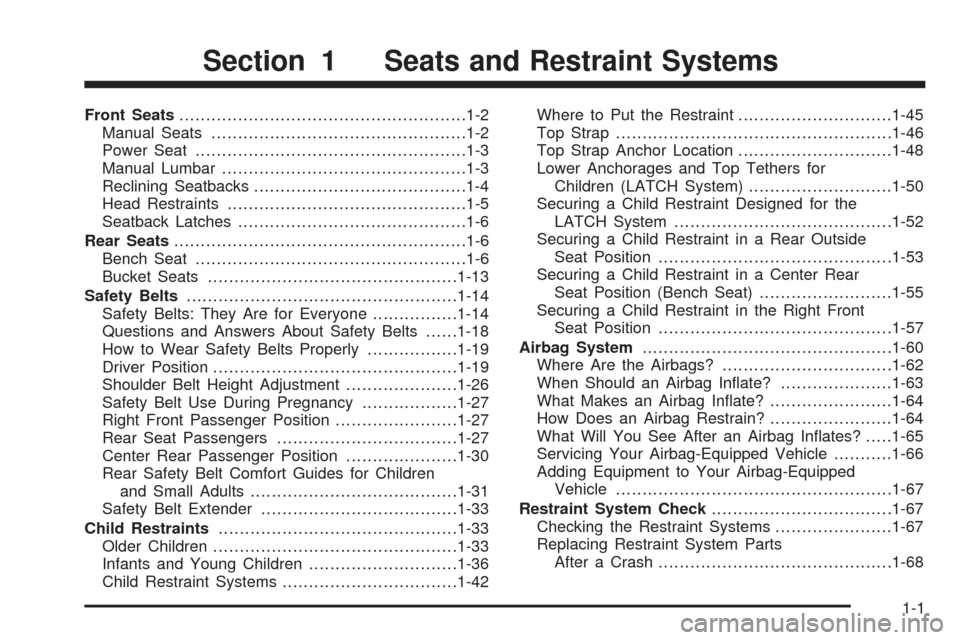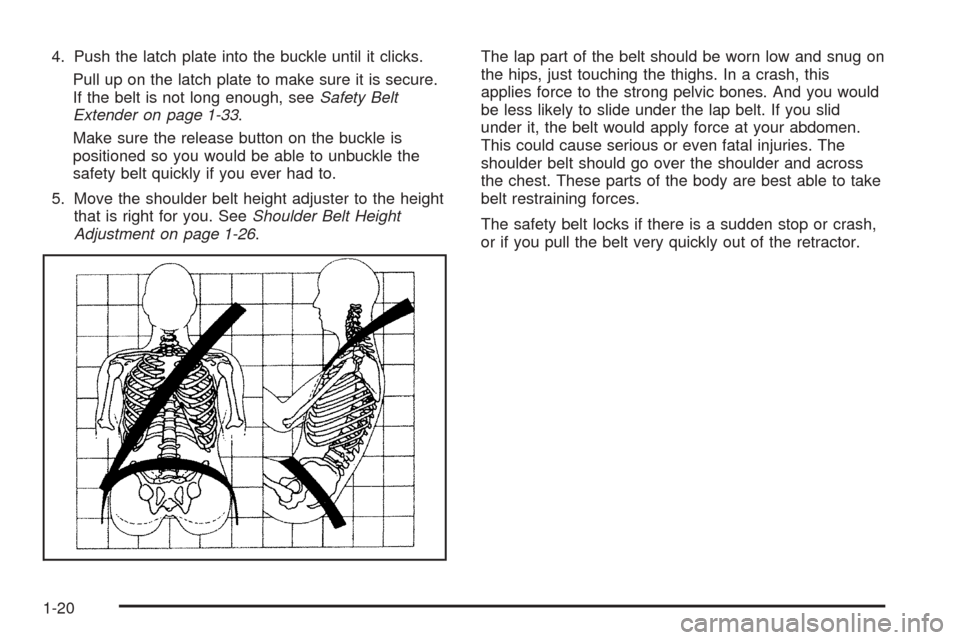Page 7 of 370

Front Seats......................................................1-2
Manual Seats................................................1-2
Power Seat...................................................1-3
Manual Lumbar..............................................1-3
Reclining Seatbacks........................................1-4
Head Restraints.............................................1-5
Seatback Latches...........................................1-6
Rear Seats.......................................................1-6
Bench Seat...................................................1-6
Bucket Seats...............................................1-13
Safety Belts...................................................1-14
Safety Belts: They Are for Everyone................1-14
Questions and Answers About Safety Belts......1-18
How to Wear Safety Belts Properly.................1-19
Driver Position..............................................1-19
Shoulder Belt Height Adjustment.....................1-26
Safety Belt Use During Pregnancy..................1-27
Right Front Passenger Position.......................1-27
Rear Seat Passengers..................................1-27
Center Rear Passenger Position.....................1-30
Rear Safety Belt Comfort Guides for Children
and Small Adults.......................................1-31
Safety Belt Extender.....................................1-33
Child Restraints.............................................1-33
Older Children..............................................1-33
Infants and Young Children............................1-36
Child Restraint Systems.................................1-42Where to Put the Restraint.............................1-45
Top Strap....................................................1-46
Top Strap Anchor Location.............................1-48
Lower Anchorages and Top Tethers for
Children (LATCH System)...........................1-50
Securing a Child Restraint Designed for the
LATCH System.........................................1-52
Securing a Child Restraint in a Rear Outside
Seat Position............................................1-53
Securing a Child Restraint in a Center Rear
Seat Position (Bench Seat).........................1-55
Securing a Child Restraint in the Right Front
Seat Position............................................1-57
Airbag System...............................................1-60
Where Are the Airbags?................................1-62
When Should an Airbag In�ate?.....................1-63
What Makes an Airbag In�ate?.......................1-64
How Does an Airbag Restrain?.......................1-64
What Will You See After an Airbag In�ates?.....1-65
Servicing Your Airbag-Equipped Vehicle...........1-66
Adding Equipment to Your Airbag-Equipped
Vehicle....................................................1-67
Restraint System Check..................................1-67
Checking the Restraint Systems......................1-67
Replacing Restraint System Parts
After a Crash............................................1-68
Section 1 Seats and Restraint Systems
1-1
Page 26 of 370

4. Push the latch plate into the buckle until it clicks.
Pull up on the latch plate to make sure it is secure.
If the belt is not long enough, seeSafety Belt
Extender on page 1-33.
Make sure the release button on the buckle is
positioned so you would be able to unbuckle the
safety belt quickly if you ever had to.
5. Move the shoulder belt height adjuster to the height
that is right for you. SeeShoulder Belt Height
Adjustment on page 1-26.The lap part of the belt should be worn low and snug on
the hips, just touching the thighs. In a crash, this
applies force to the strong pelvic bones. And you would
be less likely to slide under the lap belt. If you slid
under it, the belt would apply force at your abdomen.
This could cause serious or even fatal injuries. The
shoulder belt should go over the shoulder and across
the chest. These parts of the body are best able to take
belt restraining forces.
The safety belt locks if there is a sudden stop or crash,
or if you pull the belt very quickly out of the retractor.
1-20
Page 32 of 370
To unlatch the belt, just push the button on the buckle.
The belt should go back out of the way.
Before you close the door, be sure the belt is out of the
way. If you slam the door on it, you can damage both the
belt and your vehicle.
Shoulder Belt Height Adjustment
Before you begin to drive, move the shoulder belt
adjuster to the height that is right for you.
To move it down, push it in at the top of the arrows and
move the height adjuster to the desired position. You can
move the adjuster up just by pushing up on the shoulder
belt guide. After you move the adjuster to where you want
it, try to move it down without pushing it in to make sure it
has locked into position.
Adjust the height so that the shoulder portion of the belt is
centered on your shoulder. The belt should be away from
your face and neck, but not falling off your shoulder.
1-26
Page 248 of 370

Brake Pedal Travel
See your dealer if the brake pedal does not return to
normal height, or if there is a rapid increase in
pedal travel. This could be a sign of brake trouble.
Brake Adjustment
Every time you make a brake stop, your disc brakes
adjust for wear.
Replacing Brake System Parts
The braking system on a vehicle is complex. Its many
parts have to be of top quality and work well together if
the vehicle is to have really good braking. Your
vehicle was designed and tested with top-quality GM
brake parts. When you replace parts of your braking
system — for example, when your brake linings
wear down and you need new ones put in — be sure
you get new approved GM replacement parts. If you do
not, your brakes may no longer work properly. For
example, if someone puts in brake linings that are wrong
for your vehicle, the balance between your front and
rear brakes can change — for the worse. The braking
performance you have come to expect can change
in many other ways if someone puts in the wrong
replacement brake parts.
Battery
Your vehicle has a maintenance free battery. When it is
time for a new battery, get one that has the replacement
number shown on the original battery’s label. We
recommend an ACDelco
®replacement battery. See
Engine Compartment Overview on page 5-12for battery
location.
Warning:Battery posts, terminals and related
accessories contain lead and lead compounds,
chemicals known to the State of California to cause
cancer and reproductive harm. Wash hands after
handling.
Vehicle Storage
If you are not going to drive your vehicle for 25 days
or more, remove the black, negative (−) cable from
the battery. This will help keep your battery from
running down.
5-40